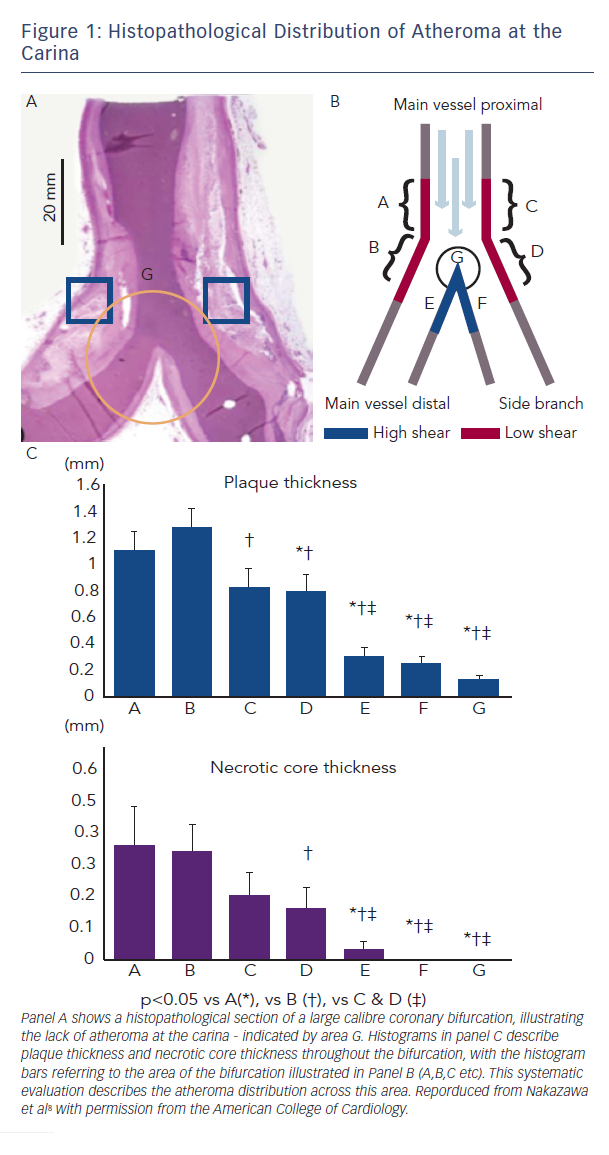A bifurcation lesion within the coronary arterial circulation is defined as a stenosis occurring at, or adjacent to, a significant division of a major epicardial coronary artery.1 Bifurcation lesions account for 1–20 % of all percutaneous coronary interventions (PCIs), and treatment remain technically challenging despite advances in PCI techniques and third-generation drug-eluting stent (DES) technology. In general, outcomes are less favourable, with an increase in the rates of major adverse cardiac events (MACE), target lesion revascularisation (TLR) and target vessel revascularisation.2,3
Recommendations from the European Bifurcation Club (EBC)1 derived from a systematic evaluation of over 10 years of data comparing a provisional single stent (main vessel [MV] only) with a planned two stent (MV plus side branch [SB]) conclude that a provisional single-stent approac h should be the technique of choice for the treatment of the majority of bifurcation lesions. If SB coverage is then required, either a T or T and protrude (TAP) technique can be adopted to secure Thrombolysis in Myocardial Infarction flow.1 Favourable results with this technique, however, is dependent on successful SB rewiring, which may be technically challenging, particularly when SB vessels contain significant ostial disease. Difficulties may also be encountered when treating disease in the distal MV once the SB has been treated with TAP configuration and especially with a long neocarina protruding into the MV.
h should be the technique of choice for the treatment of the majority of bifurcation lesions. If SB coverage is then required, either a T or T and protrude (TAP) technique can be adopted to secure Thrombolysis in Myocardial Infarction flow.1 Favourable results with this technique, however, is dependent on successful SB rewiring, which may be technically challenging, particularly when SB vessels contain significant ostial disease. Difficulties may also be encountered when treating disease in the distal MV once the SB has been treated with TAP configuration and especially with a long neocarina protruding into the MV.
Despite their overall recommendations, the EBC concede that there will always remain a role for an upfront two-stent strategy covering both MV and SB.1 There are a number of two-stent strategies available, as outlined in the comprehensive review by Louvard et al.4 None of these have demonstrated any benefit over provisional MV stenting in the randomised trials, with the exception of the double kiss (DK) crush technique.5 Despite this, MV and SB two-stent techniques continue to be performed by PCI operators largely because the SB disease is considered to be causative of ischaemia or the SB would be significantly compromised by an MV-only stent strategy and needs to be protected first with a stent.
To be certain of ostial coverage, all two-stent bifurcation techniques (crush/TAP/culotte etc) result in neocarina formation, with multiple metallic stent layers overlapping. Compounding this is the inherent geometric disparity between the Y-shape of the bifurcation and the cylindrical tube of an expanded stent.6 This can delay healing, with reduced intima formation over these sites, which may explain the higher incidence of procedural myocardial infarction (MI), stent thrombosis and restenosis that has been observed with such techniques.7 The carina itself is subject to high shear stress and flow, and hence often free from significant atheroma. Systematic histopathological analysis has confirmed this, questioning the benefit of covering this area with metal (Figure 1).8 An interventional technique that avoids creation of a neocarina, leaving it ‘metal free’ and facilitating SB access may, therefore, offer advantages in the treatment of complex bifurcation lesions.
One solution to these issues is the dedicated AXXESS™ bifurcation stent system (Biosensors Interventional Technologies, Singapore). This follows a provisional strategy while offering predictable access to the SB and MV in the long term, with the absence of metallic layers at the carina. The aim of this article is to describe the AXXESS system and the techniques employed at implantation, and to summarise the growing evidence base to support its use in the treatment of complex coronary bifurcation lesions.